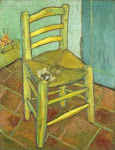

On the evening of November 3rd, Sotheby's NYC will be hosting its fall Impressionist and Modern Art night sale. Among other goodies, including a very nice Munch, is this van Gogh painting of a plaster cast, dating from his time in Paris (1887). The estimate is $ 7- 10 million. The provenance is solid and can be traced back to the van Gogh family collection; collector Paul Cassirer acquired the painting from Johanna van Gogh-Bonger in 1910, and the painting was first publicly exhibited in Berlin in 1914. The picture here comes from the Sotheby's website; they have a larger image available there.
Learning to draw and paint from plaster casts, especially casts of antiquities, was a mainstay of the academic tradition. Vincent had the opportunity to work from casts in the fine arts academy in Antwerp, which he briefly attended before going to Paris in February 1886, and also in the studio of Fernand Cormon, where he took instruction after arriving in Paris. In Cormon's studio, he met such fellow artists as Henri de Toulouse-Lautrec and Émile Bernard. Bernard later described Vincent working in front of casts: "Seated before a plaster cast of a classical sculpture, he copies the beautiful forms with the patience of a saint. He wants to seize hold of these contours, those masses, those reliefs. He corrects himself, passionately starts afresh, erases, until finally he wears a hole in the paper with the vigorous rubbing of his eraser." *
Vincent's many drawings and sketches after casts, as well as some paintings, reveal his determination to master the human figure, especially the nude. He also had a small collection of reduced-scale plaster casts at home; the painting to be auctioned was done after one of these. The actual cast, along with a few others, is still in the collection of the Van Gogh Museum. A display-case of them was set up in the galleries during my 2007 visit. He could have acquired them any number of places in Paris; they were sold in shops and even by street vendors for not much money. While some casts he drew and painted multiple times, this one he seems to have depicted only once.
I've seen a picture of the painting before, and when I saw the cast too, it made my classicist alarm go off. The other casts of Venus that Vincent used are clearly based on real Venus sculptures and exhibit classical poses. But this one is weird. Someone can feel free to correct me, but I can't visualize in my mental leafing through ancient statues of Venus an example of a Venus seated like this. It's not very 'ladylike' compared to other examples (mentally extend those broken legs out and you'll see what I mean). If I may go out on a limb here (pun intended), I think the cast-maker took the Belvedere Torso -- an extremely famous sculpture very popular as casts for study -- and made it female. I include here a picture of the Torso as a comparison. If that is correct, then this cast would have been made in one of the literally hundreds of private casting workshops in Paris, not an 'official' workshop connected with the Louvre or École des Beaux-Arts. Which would explain why Vincent could afford it!
*1911 quote, trans. in M. Vellekoop and S. van Heugten, eds., Vincent van Gogh Drawings, vol 3: Antwerp and Paris (Van Gogh Museum 2001) p. 141.






No comments:
Post a Comment